Cover Image Credit: 7Narwen on Deviantart, based on maps by Matt Springett.
Disclaimer: The following discussion contains a bunch of minor spoilers for Guy Gavriel Kay books. Read on at your own peril!
Guy Gavriel Kay is without a doubt one of the foremost fantasy authors of the post-Tolkien generation, although he can often get skipped over. He stands out to me, amidst the recent trend towards epic and grimdark fantasy, because his books are beautiful, poetic, and embrace stories of love and loss. Kay has a knack for bringing passion and drama to life on the page and his characters are intensely human and relatable.
Kay was born in Toronto in 1954 (a Canadian like myself) and educated as a lawyer at the University of Toronto. However, what’s significant about Kay’s past — and what you might call a seminal moment for him as a fantasist — was when he was chosen by Christoper Tolkien as an assistant to help edit the collected works of the master himself, J.R.R. Tolkien.
Details about Kay’s involvement with the Tolkien estate is not readily available online, although I’m sure you could dig around and find more than I did. Regardless, Tolkien’s influence can be felt on Kay’s first work, The Fionavar Tapestry, which pays clear homage to The Lord of the Rings in various ways. I’ve written about The Fionavar Tapestry in an older blog — so I won’t go into much depth here.
What’s interested about Kay’s later development as a writer is that he strayed away from the prevailing trend towards large, epic series (like contemporaries, such as Robert Jordan, George R.R. Martin, etc.). Instead, Kay has published mainly standalone books (or duologies). His books have been of consistently high quality, most set in the same shared secondary world, which closely resembles medieval Europe (see map above).
When recommending GGK to a friend, I’m often torn about where to tell them to start. There are so many great Kay books, it can be very hard to choose. This post is an attempt to create a rough ranking of Guy Gavriel Kay’s books from best to worst. Since creating any kind of strict numerical ranking proved too difficult, so I decided to put them in a tier list instead.
In the following discussion, I’ll go into some detail on each book: what I like about it, what I don’t like, why you should or shouldn’t read it. My hope is that the post will serve as a helpful guide for people who want to start reading Kay, read more if they’ve already read one or two books, or provoke some interesting discussion for Kay aficionados.
One thing I’ve found when discussing Kay in the past is that everyone seems to very different opinions about his best books. If you think that I’m wrong about one of my rankings, please feel free to leave a comment below! Discussion is always welcomed 🙂
Table of Contents
S Tier Books
These books showcase Kay’s strongest writing and are examples of his best work. Great places to start.
Tigana (1990) | S+ Tier
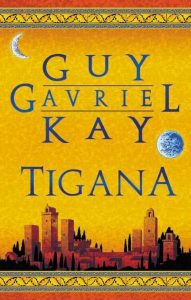 In my opinion, Tigana is Guy Gavriel Kay’s masterpiece. Based on Goodreads ratings, it is Kay’s most widely read work and often the book people will associate with him. It is the first of his standalone novels and was written in 1990, shortly after the publication of The Fionavar Tapestry.
In my opinion, Tigana is Guy Gavriel Kay’s masterpiece. Based on Goodreads ratings, it is Kay’s most widely read work and often the book people will associate with him. It is the first of his standalone novels and was written in 1990, shortly after the publication of The Fionavar Tapestry.
In my opinion, Tigana is the best place to start reading Kay. If some of Kay’s later works, like The Lions of Al-Rassan or even Under Heaven, are the polished gems of Kay’s oeuvre, then Tigana is the diamond in the rough. There are many parts of this book that feel uneven, especially when you return to it after reading Kay’s later work. But despite this, the soul of the book is so pure and moving it will take your breath away.
Tigana is the story of a nation whose name is being forgotten. Set in the fictional Peninsula of the Palm (a secondary world Kay does not explore in any of his other novels), the story revolves around a war between the sorcerers of two invading empires (Brandin of Ygrath and Alberico of Barbadior) and the struggles of the peninsula’s native inhabitants.
Before the story begins, the son of the sorcerer-king Brandin of Ygrath is killed in a battle against the soldiers of Tigana. In retribution, Brandin curses the province of Tigana, so no one except its inhabitants can remember its true name. Upon conquering the province, he changes the name to Lower Corte and destroys all traces of its once-great history.
The story opens to a deadlock between the two sorcerers, who are fighting for control of the peninsula. Into this tumultuous atmosphere, a conspiracy is born — a conspiracy among the exiled peoples of Tigana, aimed at killing Brandin and breaking his curse for good, while simultaneously freeing the peninsula from the influence of both sorcerers.
One of the best things about Tigana is its conceptual strength. The idea of a nation fighting for its very identity, its history, hooked me immediately. As with all of Kay’s books, Tigana is populated with a cast of passionate and relatable characters from all walks of life: the exiled prince of Tigana, Alessan; the singer Devin, inadvertently thrust into the heart of their plot; the concubine, Dianora, who plots of vengeance; and many others
The tragic stories of these characters interweave throughout the course of the novel, leading to many dramatic moments and unexpected pitfalls. Although Kay has a penchant for tragic endings, I would say Tigana is particularly tragic. It is one book where I vividly remember crying at the end — which I hope does not spoil things too much.
Tigana is a book I have read many times and I know I will read many more times. I cannot even pick up the book without the urge to read it again. The tension and the drama of the conspiracy, the passion and the loss of the characters’ struggle — it all creates such a compelling atmosphere, it is always tempting to dive in again.
Even if you read nothing else by Kay, you should read Tigana.
The Lions of Al-Rassan (1995) | S Tier
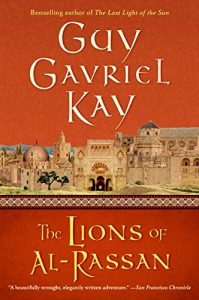 The Lions of Al-Rassan is Kay’s third historical fantasy novel and the first novel in which we are introduced to Kay’s fantasy analogue of medieval Europe, which is further explored in later books. This first novel is set in an analogue of Moorish Spain, called alternately Al-Rassan or Esperaña.
The Lions of Al-Rassan is Kay’s third historical fantasy novel and the first novel in which we are introduced to Kay’s fantasy analogue of medieval Europe, which is further explored in later books. This first novel is set in an analogue of Moorish Spain, called alternately Al-Rassan or Esperaña.
While Kay’s previous book, A Song for Arbonne, is all about gender, this book’s thematic focus is religion. In the world of Al-Rassan, Kay has created three animistic religions to stand in for our Judeo-Christian religions:
-
- The Jaddites, who worship the sun. (Christians)
- The Kindath, who worship the moons. (Jews)
- The Asharites, who worship the stars. (Muslims)
The Asharites conquered the peninsula of Esperaña from the Jaddites generations ago, re-naming it Al-Rassan and establishing a caliphate there. Meanwhile, the fragmented Jaddite kingdoms to the north dream of re-conquering the peninsula, while the Kindath communities live among both races and basically just try to survive and avoid persecution.
Three of the novel’s main characters are, respectively, Jaddite, Kindath, and Asharite, so the differing perspectives of the three religions are explored throughout the novel. The main character, Jehane bet Ishak, is a beautiful and intelligent Kindath physician, who is renowned for her skill in medicine. When something terrible in her home city of Fezana, she is forced to leave home and go abroad to seek her fortune in the rest of Al-Rassan
Her companions are the Jaddite captain, Rodrigo Belmonte, a mighty soldier who owns a ranch in the northern lands of Esperaña, and the Asharite poet and diplomat, Ammar ibn Khairan. By happenstance, this unlikely trio finds themselves exiled to the city-state of Ragosa, where they develop strong bonds of friendship — before they find themselves drawn into a larger conflict against one another, as a result of their different religions.
The Lions of Al-Rassan is a real page turner that constantly rushes from one moment of high tension to the next. Yet, at the same time, there are sections where Kay’s hallmark poeticism shows itself and really lead you into self-reflection, as his characters are forced to choose between family, faith, and love.
One of the things that I like best about this book are the surprise twists that keep you guessing right until the end of the story. There are several moments in this book where you will find yourself gasping, hand to your mouth — as Kay pulls your expectations this way and that.
The Lions of Al-Rassan is Kay at his best, delivering emotion, suspense, and action in equal measure. It is one of my favourite books and continues to be relevant in a world where, like Al-Rassan, religion is constantly dividing us.
A Tier Books
These books are good places to start in the Kay cannon. Some have minor issues, but they are well-rounded for the most part.
The Sarantine Mosaic (1998-2000) | A+ Tier
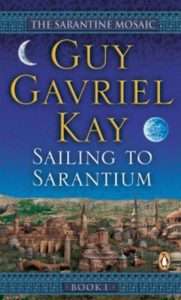
 The Sarantine Mosaic is a duology, consisting of two books: Sailing to Sarantium (1998) and Lord of Emperors (2000). Both book titles make reference to expressions in Kay’s historical fantasy world and are inspired by W.B. Yeats.
The Sarantine Mosaic is a duology, consisting of two books: Sailing to Sarantium (1998) and Lord of Emperors (2000). Both book titles make reference to expressions in Kay’s historical fantasy world and are inspired by W.B. Yeats.
To say you are ‘sailing to Sarantium’ (in Kay’s world) means that you are taking a great chance to seek your fortune. The Lord of Emperors is a reference to a Jaddite prayer, acknowledging the fact that even emperors must bow before God in death.
As should be evident from these titles, The Sarantine Mosaic is a series about legacy and the cost of building a legacy for yourself — regardless of who you are. That cost is laid bare over the course of the series in beautiful, heart-wrenching detail.
The Sarantine Mosaic is Kay’s first series after Fionavar, and set in Kay’s analogue of medieval Europe, focusing on the Imperial city of Sarantium, which readers may know as either Byzantium, Constantinople, or Istanbul . The story is an epic that takes readers from ancient Rhodia or Batiara (Rome, Italy), through the wilds of Sauradia (Balkans), and beyond to the Bassanid Empire (Sassanid Persia).
The novel’s main character is the Rhodian mosaicist Caius Crispin, who is summoned to construct a mosaic by the Emperor of Sarantium on the ceiling of his new Holy Sanctuary to Jad. This massive building is intended to be part of the Emperor’s legacy and Crispin quickly finds himself embroiled in the politics of the Imperial Court as a result of his new project.
The story of The Sarantine Mosaic can be easily summed up, but it’s the journey taken by Crispin that makes the story truly shine among Kay’s other works. For one thing, there are the fabulously clever characters of the Emperor Valerius II and his Empress, Alixana, a former dancer, who steal the show whenever the appear on the page.
Then there are the great chariot races, staged in the hippodrome and described in pulse-pounding detail, as the factions of the Blues and Greens race for glory. Alongside these are a host of other fascinating characters: the exiled Batiaran Queen, Gisel; the seductive dancer of the Greens, Shirin; the too-perfect Supreme Strategos, Leontes; his powerful and dangerous wife, Styliane Daleina; the Bassanid physician, Rustem; and many more.
As befits an epic, The Sarantine Mosaic is populated by a true cast of thousands. Some readers may find it overwhelming or dislike the long build-up in Sailing to Sarantium, but I personally find that the moments of tension that Kay delivers in Lord of Emperors are unrivalled in his other works. There’s a real sense of threads coming together after hundreds of pages of stage-setting and the results are spectacular.
As with Kay’s other works, you are kept guessing with constant twists and turns of the plot over the last few hundred pages. And there is sadness — real sadness — when the final conclusion comes. While there may be happy endings in Kay’s books, they always come at a high cost.
If you enjoy fantasy or historical fiction on an epic scale, then I highly recommend The Sarantine Mosaic. Although this series might be underrated by some, I believe that this is Kay at the top of his game, creating a work of breath-taking scale and ambition — and pulling it off spectacularly.
A Song for Arbonne (1993) | A Tier
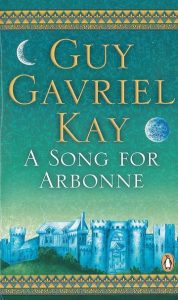 A Song for Arbonne is a historical fantasy set in a parallel world that greatly resembles medieval, troubadour France — along with Tigana, it is one of the others not in Kay’s principal shared world. The main conflict of the novel concerns the incipient war between two neighbouring nations, Gorhaut and Arbonne, whose cultures are distinctly at odds with one another.
A Song for Arbonne is a historical fantasy set in a parallel world that greatly resembles medieval, troubadour France — along with Tigana, it is one of the others not in Kay’s principal shared world. The main conflict of the novel concerns the incipient war between two neighbouring nations, Gorhaut and Arbonne, whose cultures are distinctly at odds with one another.
Arbonne is a warm land, full of song and wine, where the goddess Rian is revered above all others and women rule the country. In cold, warlike Gorhaut, the god Corannos is held in highest esteem — and its militaristic, male rulers have a fanatical hatred for women and the culture of Arbonne to the south.
A Song for Arbonne is Kay’s third novel and the second in which he begins to employ his distinctive style of “historical fantasy”. It is deeply poetic and the story is driven by several excellent character dynamics: the mortal enmity between the dukes of Talair and Miraval in Arbonne; the hatred of the exiled Blaise of Gorhaut for his father, Galbert the High Elder of Corannos; and the lust of King Agemar for Blaise’s sister-in-law, the Lady Rosala.
These threads weave together a rich and interesting story, with many twists and turns that keep you enthralled until the end. There are certainly some plot points that stretch credulity or come across heavy-handed, which is a weakness of some of Kay’s early work, but the novel is a compelling read from start to finish and a real page-turner.
On my second reading of A Song for Arbonne (almost ten years after I first read it), I was really struck by the feminist message of the novel. The story of Arbonne and Gorhaut is one that continues to play out in our world today and the book manages to feel like a very relevant commentary, even two decades after publication.
The book explores themes of love, jealousy, and forgiveness in complex, nuanced ways that does it great credit. Even as a teenager (when I was most interested in the sex scenes), I felt like this book helped me to understand love and relationships in a more nuanced way than I had before. I highly recommend it to young adults and older teens — especially men.
A Brightness Long Ago (2019) | A Tier
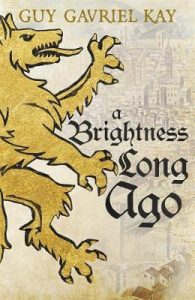 Kay’s most recent published work, A Brightness Long Ago, feels like a welcome return to form — as well as a return to the beloved Jaddite world, shared by many of his previous works. The time period of the story advances to the equivalent of Italian Renaissance and there will be familiar names and places mentioned, which carry over from Children of Earth and Sky.
Kay’s most recent published work, A Brightness Long Ago, feels like a welcome return to form — as well as a return to the beloved Jaddite world, shared by many of his previous works. The time period of the story advances to the equivalent of Italian Renaissance and there will be familiar names and places mentioned, which carry over from Children of Earth and Sky.
The story is about the violent struggles of the city-states of Batiara (Italy). From the novel’s first pages, you are introduced to midnight intrigues, assassination plots, and the beginning of tragic love affairs. While earlier Kay books are occasionally guilty of taking some time to build to the moments of high drama, you are thrust right into the heart of them with A Brightness Long Ago.
The narrative is split between a first-person account and a third-person account, which makes for an interesting contrast. The first narrator is Guidanio Cerra, or simply Danio, a young man from Seressa (Venice), who gets caught up in a conflict between two neighbouring city-states. Danio has been well-taught by one of the brightest minds of the day, but he has little means and finds himself involved in events beyond his station — and forced to make the most of them. The other narrator is Adria Ripoli, the youngest daughter of the Duke of Marcera (Milan), who has eschewed the typical pursuits of her gender for something more meaningful.
Over the course of the novel, the paths of these two figures will intertwine and cross with others: the rivals Folco d’Acorsi and Teobaldo di Remigio; the healer Jelena; the corrupt and power-hungry Sardi family; and many others. A Brightness Long Ago is a love story, at its core, but also a story about making your way in the world.
If you’re a fan of Renaissance history, you will doubtless notice parallels to the Borgias and Medicis, among others. As usual, Kay uses history to add richness and complexity to his novels, while deviating from it when it does not serve his purposes. A Brightness Long Ago shows him using this technique again, similar to the Sarantine duology.
The different historical time period of A Brightness Long Ago makes it an interesting entry point into Kay’s work. If you read his previous novels in the Jaddite world, you will recognize names and even some character call-outs from Children of Earth and Sky (which seems to be only a generation or so removed from it), but missing these won’t take away from your enjoyment or your immersion in the narrative.
A Brightness Long Ago offers a refreshing return to the drama and passion of Kay’s best novels, while maintaining the polishing storytelling, which seem to distinguish his other later works. It can be either a great place to start, or a welcome continuation of the ongoing story he is telling.
Under Heaven (2010) | A Tier
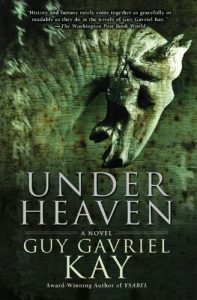
Discussion coming!
River of Stars (2013) | A Tier)
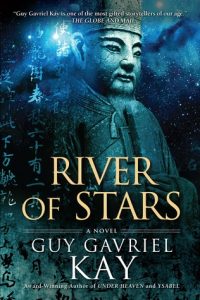
Discussion coming!
B Tier Books
These books are a good read, but have some flaws that will make them unappealing to certain readers. I wouldn’t recommend starting with these books, unless you’re attracted to them for a specific reason.
The Fionavar Tapestry (1984-86) | B+ Tier
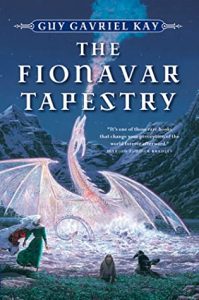 The Fionavar Tapestry is a high fantasy epic, consisting of three novels written between 1984 and 1986. It was Kay’s first work and written shortly after he worked as an editor on the posthumously published works of J.R.R. Tolkien, with the author’s son, Christopher Tolkien.
The Fionavar Tapestry is a high fantasy epic, consisting of three novels written between 1984 and 1986. It was Kay’s first work and written shortly after he worked as an editor on the posthumously published works of J.R.R. Tolkien, with the author’s son, Christopher Tolkien.
The story takes place in the fictional world of Fionavar, which the five main characters visit from ours using magic, in order to help in the epic struggle against the evil Rakoth Maugrim, the Unraveller. The book pays clear homage to the Inklings — in particular Tolkien — intertwining mythic archetypes from Celtic, Welsh, and Norse lore, in addition to other cultures.
As Kay’s first work, I found that The Fionavar Tapestry has a few problems that are not present in Kay’s later works. The series struggles to live up to its ambitious goals (paying homage to Tolkien, Lewis, et al). Its five main characters are also underdeveloped in some respects, in particular Jennifer, and the story suffers from some pacing issues later in the series.
If you’re interested, you can read my in-depth discussion of the problems of The Fionavar Tapestry in my previous blog.
Overall, the Fionavar Tapestry is a highly ambitious first work that continues to be heralded as a high fantasy classic by many genre fans. While it has some issues, which the author manages to avoid in his later work, it nonetheless remains an important work of fantasy.
Not every Kay reader will enjoy the Fionavar Tapestry. The book is markedly different from the rest of his oeuvre, with the sole exception of Ysabel, which ties into the story of Fionavar and is also partly set in our own world.
If you are drawn to Kay’s brand of historical fantasy, you may find the classic high fantasy of Fionavar does not suit you. If that’s the case, I would encourage you to give this book a pass and try something else first. If you’re coming to Kay as a high fantasy buff, then this work may be a good place to start, as the tropes will be familiar and more accessible.
Ysabel (2007) | B Tier
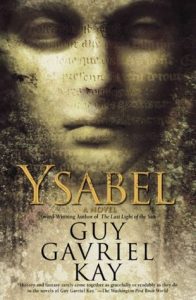
Discussion coming!
Children of Earth and Sky (2016) | B Tier
 Children of Earth and Sky is a historical fantasy novel that returns us to the shared world of many of Kay’s previous novels (The Sarantine Mosaic, The Lions of Al-Rassan, and The Last Light of the Sun). This story is inspired by Adriatic cultures, focusing on the cities of Serassa and Dubrava (which are analogues of the real world cities of Venice and Dubrovnik), and their interactions with the nearby Osmanli (Ottoman) Empire.
Children of Earth and Sky is a historical fantasy novel that returns us to the shared world of many of Kay’s previous novels (The Sarantine Mosaic, The Lions of Al-Rassan, and The Last Light of the Sun). This story is inspired by Adriatic cultures, focusing on the cities of Serassa and Dubrava (which are analogues of the real world cities of Venice and Dubrovnik), and their interactions with the nearby Osmanli (Ottoman) Empire.
The novel is full of political intrigues. There is a vast religious war being waged in the background of the story, between the advancing Osmanlis and the remnants of the Christian (Jaddite) faith. The cities of Serassa and Dubrava are bargaining to ensure their continued prosperity and relevance in the world. And there are a lot of young people caught up in the turmoil and trying to find their way.
I found Children of Earth and Sky to be a really lovely story on the whole. As with much of Kay’s later work, it is very well-polished and reads very easily. If you loved the shared world of his early works, it is sure to be a welcome reunion and you’ll enjoy the subtle call-backs to other novels, particularly The Sarantine Mosaic duology.
That being said, I don’t recommend Children of Earth and Sky as a starting point and that’s why I’m placing it in the B Tier. Unlike previous books, the story and the events in Children of Earth and Sky feel very peripheral and, while the events are significant to the lives of its main characters, it lacks the memorable, epic qualities that make some of Kay’s other work really shine.
In many ways, I found the book similar to The Last Light of the Sun. It’s set in the same shared world, it feels like a filler story, and it doesn’t have anything that really sets it apart. However, I do feel like Kay struck a tone in this book that favourably called to mind The Sarantine Mosaic, which The Last Light of the Sun lacked this to its detriment. It also avoided the latter book’s sometimes heavy-handed violence — setting it firmly above it on my list.
In the end, I found Children of Earth and Sky to be a welcome addition to Kay’s body of work, while not being a story that stands out particularly for me. I’d suggest reading it if you’re dying for more about The Sarantine Mosaic and want something with a similar tone and setting.
Sidenote: I love the cover art for this book — if I was making this tier-list on cover alone, it would be S-Tier for sure.
C Tier Books
This tier is home to a single lonely book — a testament to Kay’s overall skill as a writer.
The Last Light of the Sun (2004) | C Tier
 The Last Light of the Sun is a historical fantasy novel written by Kay in the middle of his career, and loosely based on the historic Viking raids made against Saxon England in the 11th century. The story takes place in the same shared world as a number of other Kay books (The Lions of Al-Rassan, The Sarantine Mosaic, and Children of Earth and Sky) in Kay’s analogue of medieval Europe.
The Last Light of the Sun is a historical fantasy novel written by Kay in the middle of his career, and loosely based on the historic Viking raids made against Saxon England in the 11th century. The story takes place in the same shared world as a number of other Kay books (The Lions of Al-Rassan, The Sarantine Mosaic, and Children of Earth and Sky) in Kay’s analogue of medieval Europe.
While some people may disagree with me, I believe that this is hands-down the worst book that Kay has ever published. Even at that, it’s not a bad story (which is why it’s C Tier vs. D Tier) and I did enjoy reading it the first time. However, unlike most of Kay’s other books, I wouldn’t recommend it to others or really consider re-reading.
From my perspective, The Last Light of the Sun arrives as a poor addendum after a string of strong novels set in his shared world. Both The Lions of Al-Rassan and The Sarantine Mosaic duology (the novel’s chronological predecessors) are ranked very highly on this list, and The Last Light of the Sun comes as a bit of a let down after them.
Personally, I get the sense that Kay had some trouble with this book. It took him the longest to publish The Last Light of the Sun — almost four years, when most of his books took only two or three — and I wonder if that’s something behind that. Writer’s block or burnout from the Sarantium duology? Who knows…
This book represents a bit of shift in his writing career, where he transitions from his more loosely-written earlier novels to more polished novels afterward. Both periods offer great reads, although I am prejudiced towards his earlier stuff. In the middle of the two periods is this book and Ysabel, which is mentioned above.
It is obvious that this was an area of history that Kay wanted to explore and probably one that he’d researched in the process of writing The Sarantine Mosaic. It may be something that he simply felt he had to write, in order to move on to other things. Whatever the case, we got The Last Light of the Sun.
The Last Light of the Sun focuses on a mixture of Viking and Celtic characters on both sides of the conflict, during the invasion. As with typical Kay stories, characters’ lives intertwine and lead to moments of great conflict or drama. Unlike many of Kay’s other stories, it lacks as many strong female characters (at least in leading roles). It also has a lot of violence.
While Kay has never shied away from depictions of violence, I found that The Last Light of the Sun was a bit of an extreme example. There’s a lot of scenes with Vikings killing people in brutal ways, which is maybe to be expected. Still, it wasn’t my cup of tea.
The story also lacks any truly distinct features that make it memorable or noteworthy, set beside his other books. It feels like a filler story and, for that reason, I’d only recommend it to readers who really loved the shared world of his early works and want to continue exploring it. I’ve certainly heard of people liking The Last Light of the Sun, but I can’t honestly say that I’m among them…

Hi Alex,
Just read your summary of Kay’s works and enjoyed it, but I disagree with you on Last Light of the Sun. I won’t try to convince you to put it in the A Tier, but I would argue that it’s extremely distinctive.
What really struck me about this book was the degree to which almost all the characters are just trying to survive in a world that they can’t influence much beyond their own sphere, if that.
In Tigana, all the main characters are trying to determine the balance of power in the Palm; in Lions of Al-Rassan, they’re doing the same for Al-Rassan/Esperana; in the Sarantine Mosaic, not only is Crispin trying to achieve immortality through art (as so many of the characters are), but he’s also a meaningful player in the highest levels of Sarantine politics.
But, in Last Light, the characters are really just trying to survive until tomorrow. Yet that survival seems to be at the mercy of an indifferent Fate, which is seemingly not even aware of their existence. When Kendra goes into the woods to try to get the spruaugh to help Alun, Kay summarizes with the paragraph:
“And so a difficult truth about human courage was played out among those trees. A truth we resist for what it suggests about our lives. But sometimes the most gallant actions, those requiring a summoning of all our will, access to bravery beyond easy understanding or description…have no consequence that matters. They leave no ripples upon the surface of succeeding events, cause nothing, achieve nothing. Are trivial, marginal. This can be hard to accept.”
I don’t think that sentiment exists in any other GGK book. Win or lose, characters in GGK’s other books mattered.
Yet, for all that, there’s something oddly hopeful here. In GGK’s other books, there’s a struggle to prevent the fall of a civilzation/society or to restore one. In Last Light, Alfred is building one. It seems to be the only book occurring at the dawn rather than the dusk of a civilization. Admittedly, that may contradict my first point, since Alfred’s actions definitely do matter, but he and Ceinion are outliers, just as Kasia from the Sarantine Mosaic feels more like the characters from Last Light than most of Kay’s other characters.
Although there are exceptions for each point I made here, I think they’re the exceptions that prove the rule. Last Light isn’t less polished than his other novels. The world he describes in Last Light is just a colder, darker, more indifferent place.
That said, I wouldn’t argue that anyone should like a given book more or less than another (I honestly thought Song for Arbonne was just OK. To me it felt like a Ren Faire depiction of medieval France/Germany, but that’s me). But, I would argue that this book does have distinct features that make it memorable.
– Steven
Hi Steven
Thanks so much for the thoughtful response!
I found your argument for the merits of Last Light of the Sun quite persuasive. I definitely hadn’t considered the book in that light before (excuse the pun) and I might have to embark on a re-read to see if I would enjoy it more with that lenses.
I think I disliked the lack of agency for the characters, when I first read it — although I’m not sure I articulated that in my review. It felt like nothing they did mattered and, to me, the world-historical importance of actions is a key draw of Kay’s writing. In his stories, actions have significance that reverberates outward across the world and that’s part of the drama that I love.
I will admit that Song for Arbonne was less engaging in my most recent re-read, but still holds a special place for me because it was the first Kay book that I ever read. After some of his other stuff, it certainly feels less polished and less unique than it did on the initial encounter.
Thanks for taking the time to comment 🙂
Best,
Alex
I agree that Last Light of the Sun deserves a better ranking. I loved it, but then I tend to gravitate towards books with a Viking theme. I read it a long time ago and memory of it is sadly fading (perhaps a re-read is in order). I do remember however getting a feeling of this book having a slow, almost understated pace to it, punctuated by violent interludes.
I also await your views on Under Heaven and A River of Stars, two books that I felt were exceptional in every way. I gave my copy of the former book to a friend who felt it was too dense and she could not make it past the first 50 pages!
Perhaps the difference between the two books, Lions and Last Light is just how you see your world and how much you can control it. Roderigo and Amir know they can bend fate with effort. They know the costs. As was said about Last Light, those characters are certain they cannot. In one you try or all is lost, the other you try though all is lost.
Ysabel was like airport fiction YA version of GGK. Which is too bad. He could have inverted it to be from the point of view of Ysabel and the two suitors in a series of interlocking stories across time in a quarter tur to fantasy setting. Instead we get a teeenager with references to ipods, coldplay, iron maiden, instantly dating it all. The suitors seem like a rough prototype of the mercenary captains in brightness as well. I am shocked it won the WFA.
Cannot agree more re: YA version of GGK. I think there are many authors that do this type of time-jump portal fantasy well, but Kay struggled a bit to make it work. Personally, I think the WFA win was more of a ‘you’ve done so much good work over the years, we’re giving it to you’ rather than the book itself deserving it… But that’s just my take!
Hi! Wonderful to see this in-depth rating and I’m wondering now where you would place All The Seas of the World. While Tigana was my first happy stumbling into Kay’s writing (by virtue of compelling cover art I spotted at a used book shop in the mid 90s), I felt this latest one held me and elicited more emotion than any of the others (except Tigana, of course). Thank you!
Hi Jesse, I haven’t had the chance to read ‘All the Seas of the World’ yet, but this is certainly high praise. I’ll definitely make it a priority so I can slot it into my list. 🙂